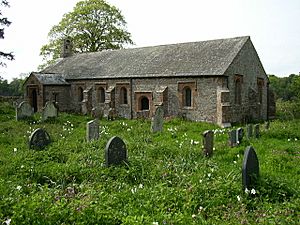Ninekirks facts for kids
Quick facts for kids St Ninian's church |
|
|---|---|

St Ninian's church
|
|
| Lua error in Module:Location_map at line 420: attempt to index field 'wikibase' (a nil value). | |
| OS grid reference | NY 5593029962 |
| Location | St Ninian's church Cumbria |
| Country | England |
| Denomination | Anglican |
| Website | https://www.visitchurches.org.uk/visit/church-listing/st-ninians-brougham.html |
| History | |
| Dedication | St Ninian |
| Architecture | |
| Functional status | closed |
| Closed | 1934 |
Ninekirks is the special local name for St Ninian's church. You can find it in Brougham, Cumbria, England. This church is named after Saint Ninian. It used to be the main church for the village of Brougham. Now, it's looked after because it's a very old and interesting building. It mostly looks like it did in the 1600s. People have called it Ninekirks since at least the year 1583.
Contents
Why Ninekirks is Special
This church is very important! It's a Grade I listed building. This means it's one of the most important historic buildings in England.
Ninekirks is special because it was built during a time called the Commonwealth of England. This was a period when England was not ruled by a king or queen. Very few churches were built then. Ninekirks has also stayed almost the same since it was built.
A Look at Ninekirks' History
Long ago, the Romans built a fort called Brocavum near Brougham. This was close to where the River Eamont and the River Eden meet. People have lived and used the Ninekirks site since Roman times.
We know Romans were here because of a collection of old coins found at Ninekirks. It's thought that Saint Ninian was linked to this area very early on. There are also caves nearby called Isis Parlis. Some people think hermits, who are people living alone for religious reasons, might have used these caves.
Around the 1200s, the main village moved closer to Brougham Hall. The Hall had its own chapel, so the church at Ninekirks wasn't used as much.
In 1659, a powerful woman named Lady Anne Clifford rebuilt the church. She owned Brougham Castle at the time. The work was finished in 1660.
Ninekirks was often used when the chapel at Brougham Hall wasn't available. For example, from 1764 until the 1840s, weddings were held at Ninekirks. This was because the Brougham Chapel needed repairs. Ninekirks itself was repaired in the 1840s. The porch was added in 1841. Old tombs inside the church were explored in 1846 during these repairs.
The church had a good period in the early 1950s. This was when Canon Bouch was the Rector. He wrote many articles about the church's history. Ninekirks was officially closed as a regular church in 1977. Now, the Churches Conservation Trust looks after it.
Family Shields Inside
The church has three special painted shields called hatchments. These shields were put up to remember important people who had died. They include:
- Elizabeth Richmond (died 1729) and Peter Brougham (died 1732).
- Eleanora Syme (died 1839) and Henry Brougham (died 1810). He was the father of the 1st Baron.
- Henry Brougham, 1st Baron Brougham and Vaux (died 1868) and Mary Anne Eden (died 1865).
Exploring the Past: Archaeology
Scientists have studied the church and its area four times to learn about its past:
- During repairs in the 1840s, old tombs inside the church were explored.
- In 1913, excavations happened at Isis Parlis. The goal was to understand how the caves formed and how people used them.
- A collection of old coins was found in 1914.
- In 1968, pictures taken from the air showed marks in the fields. These marks suggested there might have been a small monastery there long ago.
See also
- Brougham Castle
- Grade I listed churches in Cumbria
- Grade I listed buildings in Cumbria
- Listed buildings in Brougham, Cumbria
- List of churches preserved by the Churches Conservation Trust in Northern England

